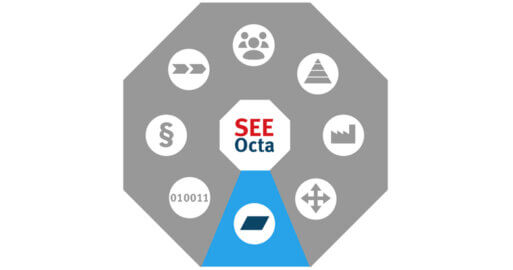SEEOcta Applications: Why Workflows are Important

Workflows are the foundation of any digitalisation project. They were used back in the first industrial revolution to make production processes as efficient as possible. In today’s digital, networked world, they define clear, efficient and transparent processes at every level and in every aspect of business. Based on these clearly defined workflows, digitalisation and integration strategies can be created that connect companies worldwide, make internal processes more efficient and provide more transparency and structure within departments. Workflow management systems allow these workflows to be managed digitally. Find out more about the role of workflows and workflow management systems in digital integration and networking.
The SEEOcta blog series highlights the eight most important perspectives for successful project management. Discover all the areas you need to consider when planning digitalisation and integration projects in your company. Armed with the ideas and knowledge in the articles, you will have a solid foundation for planning your IT project and a guide to help you ensure that no one gets left behind.
A clearly defined workflow is the foundation of any structured, process-orientated IT project. In the era of industry 4.0 and the increasing digitalisation in production, it’s clearly defined processes that allow us to start planning the digital networking for IoT- and IIoT (Internet of Things and Industrial Internet of Things) projects. At an administrative level, workflow management ensures that there are defined processes in the office. In between these two ends of the spectrum are the areas of product development, purchasing and the entire supply chain up to marketing and sales & distribution. And they all benefit from well-designed workflows with optimum structure and efficiency. Workflows are the basis for any integration or digitalisation project.
Example workflows from industry 4.0 and IoT
Production planning and scheduling (PPS) has a key role in manufacturing. It involves managing, planning and monitoring manufacturing processes all the way from the initial quotation to dispatching the product. The following are examples of workflows from industry 4.0 and the Internet of Things:
Workflows in product development
In order for a company to develop and manufacture high-quality and innovative products, several different areas need to work together, such as mechanics, electrics, electronics and information technology. To enable this mesh of skills, there needs to be collaboration between various departments and even external parties, as well as a regular exchange of engineering and product data. Collaborative product development and data exchange in mechanical engineering and other technical industries is a prime example for digitalisation processes based on optimised workflows.
Workflows in product lifecycle management
A further area in which clearly defined workflows build the basis for optimising then digitalising processes is product lifecycle management (PLM). PLM plays a key role in digitalisation in technical and electronics contexts to ensure that products are always up-to-date with customer expectations and that a new product is ready once the current one’s lifecycle has gone into decline. This naturally involves a long lead time and a wealth of information to be collected, managed and shared. Professional workflows define exactly who is responsible for what, when, to ensure that development stays on track.
Workflows in logistics
Networked, integrated digital ecosystems ensure that the right goods are at the right place at the right time. To ensure that the underlying logistics processes run as optimally as possible, the integration strategy needs to be based on pre-defined workflows, encompassing such tasks as determining stock levels and calculating how much can be delivered, to monitoring the vehicles and optimising their loads and even routes.
Although workflows have been used in manufacturing contexts for quite some time, it has taken a lot longer for them to take off for administrative processes. The processes played out in offices remained unchanged for decades. It was only once digitalisation started to take hold in administration that processes were gradually analysed and optimised in order to enable work to be done more efficiently and transparently. This optimisation is still ongoing today.
Example Workflows in administration
Thanks to automation, workflows are able to reduce the amount of legwork in coordinating administrative tasks:
Generic workflows in departments
Standardised organisational structures and clearly defined processes and responsibilities, laid out in the same way in every department, mean that structural changes can be made quickly and easily. They are also extremely useful for training up new employees –. You can read more on how generic workflows help employees in their various departments understand how they fit into the bigger picture in Get Organised! The SEEBURGER SAP Add On Generic Workflow.
Workflows help cross-departmental collaboration
Clearly defined workflows make it easier for people from different departments to collaborate with each other. Employees can quickly see who is responsible for what and how far the project has progressed. An add-on such as SEEBURGER’s SAP add-on Rule Solver lets you define your own approval processes and structures, so that anyone can see who is responsible and authorised for the next step.
Workflows for digital inbox solutions
There is enormous optimisation potential in digitalising the flood of documents and information which flows into a company via the post system. Find out how a digital inbox add-on can help make your processes more efficient and transparent or even how you can feed both digital and paper-based information into a workflow.
Manage workflows with a workflow management system
Workflow management systems are used to coordinate workflows such as those above, and automate recurring administrative. Their task is to ensure that steps are carried out by a specified application based on specific instructions…
Workflow management systems are particularly effective in areas in which several people are involved, as they significantly increase the efficiency in these administrative processes. A workflow management system follows pre-defined rules to starts administrative tasks and ensure they are carried out in the correct order, giving the users the data and information they need at each stage.
Workflow management systems consist of various components. This includes the ability to model business processes and manage them. It also includes a workflow engine, which manages processes according to defined workflows, as well as a monitoring component. It also enables you to analyse the processes, which give you insights to feed back into process modelling.
Workflow management systems have a number of advantages, including:
- Consistent processes,
- Reducing turnaround,
- Making processes more transparent,
- Simplifying and automating complex administrative processes,
- Saving time and money,
- Reducing and preventing errors
Due to their key role in a company’s digital transformation, they affect all perspectives in the SEEOcta model.
In the second part of this SEEOcta article on workflows, you can discover how workflow management systems are used in practice.
Thank you for your message
We appreciate your interest in SEEBURGER
Get in contact with us:
Please enter details about your project in the message section so we can direct your inquiry to the right consultant.
Written by: Rolf Holicki
Rolf Holicki, Director BU E-Invoicing, SAP&Web Process, is responsible for the SAP/WEB applications and digitization expert. He has more than 25 years of experience in e-invoicing, SAP, Workflow and business process automation. Rolf Holicki has been with SEEBURGER since 2005.





